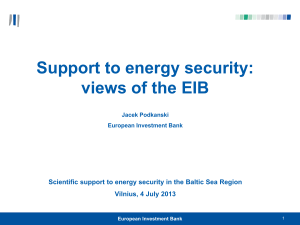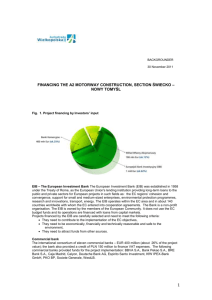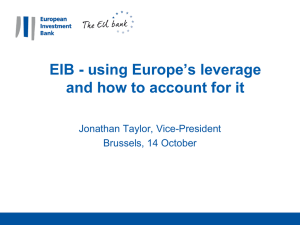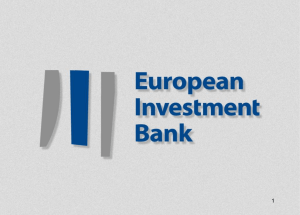presentation introducing the application process and the eligibility
advertisement
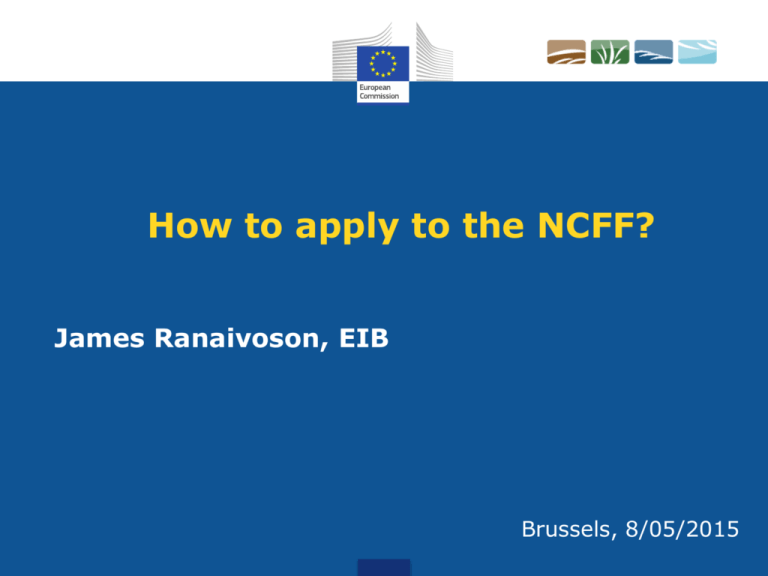
How to apply to the NCFF? James Ranaivoson, EIB Brussels, 8/05/2015 NCFF Structure LIFE EIB Environment / Climate NATURAL CAPITAL FINANCING FACILITY Co-investors FINANCIAL INSTRUMENTS private and/or public TECHNICAL ASSISTANCE EUR 100-125m EUR 50m First Loss for EIB EUR 10m Project level Investments DIRECT INVESTMENTS IN PROJECTS INTERMEDIATED INVESTMENTS: Private Equity Funds, Credit Lines to Banks 08/05/2015 European Investment Bank Group European Investment Bank 2 Page 2 Recent developments & expressed interests 08/05/2015 European Investment Bank Group 3 NCFF Delegation Agreement signed 19 December 2014 and officially launched 16 February 2015 EIB and EC are fine-tuning the criteria. Roughly 20 expressed interests are under consideration with 6 seen “potentially serious” for which EIB is requesting more information from the promoters. However, none is documented enough today to allow discussing “eligibility criteria” with the EC and qualifying as “project opportunity” for EIB The 4 categories (GI, PES, BO, PBB) are covered and more than half have Climate Adaptation (CA) components. There are interests from 1 private equity and 1 financial intermediary, the rest being for direct loans to project or public body or company/vehicle. Countries covered: CY/MT, ES, FI, FR, IE, NL, PL, PT, RO, UK. 08/05/2015 European Investment Bank Group 4 Half of the interests are to undertaking a GI project often linked with CA components Almost all proposals comprise at least 2 categories; those with PBB features are more “readable” There is no proposal led primarily by PES features today ; PES are underneath GI and/or PBB and/or CA; BO proposals are the less elaborated to date. Most of the business models are not yet clear yet about the “practical” activation of cash flows and above all on the identity of the recipients / counterparts of NCFF loans or investments. Promoters are regional authorities, public entities, conservation NGOs, financial intermediaries (FI), public or private utilities, private corporations Apart from the promoters, special vehicles grouping various stakeholders and SMEs/small legal entities funded by FIs are evoked as final recipients 08/05/2015 European Investment Bank Group 5 Eligibility Criteria 08/05/2015 European Investment Bank Group 6 Reminder from earlier presentations: “The primary objective of the NCFF is to develop a pipeline of projects in EU-28, testing different financing options in order to identify the most suitable approach. The overall objective is to provide a proof of concept demonstrating to the market, financiers and investors, the attractiveness of such operations, thereby developing a sustainable flow of capital from the private sector towards the financing natural capital and achieving scale.” EU Biodiversity Strategy targets; LIFE Regulation ; EU value-added Business Context: (i) Clear regulatory environment (ii) Existence of market for project’s bankability (iii) Sound and efficient business model 08/05/2015 European Investment Bank Group 7 In order to achieve 9-12 operations for 2015-2017 (± 3-4 projects per year), we should also keep in mind the parameters set-up for the NCFF portfolio and presented earlier: Target NCFF investments / loans per project: EUR 5-15m – Maximum EUR 15m Maximum support facility per project : EUR 1m Maximum per MS : 20% (limited to 15% for a single direct and 15% for total intermediated operations) No more than 35% in any one of the 4 categories Target term: 10 year with possibility of grace period of 3 year Maximum NCFF contribution to total project costs: 75% Maximum NCFF participation per private equity fund : 33% 08/05/2015 European Investment Bank Group 8 Assessment criteria Anne Theo Seinen, DG ENV.B.2 Brussels, 8/05/2015 Objectives of the LIFE Regulation • Projects to respond as good as possible both to Nature / biodiversity and climate adaptation objectives • Aim is to have high quality projects. Many criteria and aspects, but altogether the scope for projects remains very broad Art. 11 of the LIFE Regulation • Specific objectives for Nature and Biodiversity refer to: • - EU Biodiversity Strategy to 2020 • - Habitats and Birds Directives, including the Natura 2000 network Contribution to the LIFE Objectives • Projects must pursue one of the following two objectives as the primary objective: • promote the conservation, restoration, management and enhancement of ecosystems including through ecosystem-based solutions applied to the sectors of land, soil, forestry, agriculture, aquaculture, water and waste; and/or • promote ecosystem-based approaches that enable businesses and communities to address identified risks associated with current and projected impacts of climate change, including through urban, rural, and coastal green infrastructure projects;" LIFE Nature and biodiversity (1) • Checks: • are the targeted species and habitats listed in the annex I to the Birds Directive or annex I or II to the Habitats Directive? (Exceptions for Annex IV species are possible) • other species/habitats relevant under biodiversity considerations? LIFE Nature and biodiversity (2) • how does the project contribute to "halting the loss of biodiversity and the degradation of ecosystem services in the EU by 2020 and restoring them in so far as feasible, while stepping up the EU contribution to averting global biodiversity loss"? Six targets: 1. Fully implement EU nature legislation 2. Better protect and restore ecosystems and their services, and greater use of green infrastructure 3. More sustainable agriculture and forestry 4. Better management of EU fish stocks and more sustainable fisheries 5. Tighter controls on Invasive Alien Species 6. A greater EU contribution to averting global biodiversity loss LIFE Nature and biodiversity (3) • share of concrete conservation actions, i.e. actions that directly improve/slow/halt/reverse the decline of the conservation status / ecological condition of the species, habitats, ecosystems or ecosystem services targeted. • if high share of recurrent activities (e.g. mowing), check how long-term continuity of the project is ensured Art. 15 of the LIFE Regulation • Specific objectives for Climate Change Adaptation refer to: • - development and implementation of Union policy on climate change adaptation, (…) developing, testing and demonstrating policy or management approaches, best practices and solutions for climate change adaptation, including, where appropriate, ecosystem-based approaches; • - improve the knowledge base, integrated approaches • - development and demonstration of innovative climate change adaptation technologies, systems, methods and instruments that are suitable for being replicated, transferred or mainstreamed LIFE Climate Change adaptation (1) • Adaptation means : • anticipating the adverse effects of climate change • taking appropriate action to prevent or minimise the damage these adverse effects can cause, • taking advantage of opportunities that may arise. LIFE Climate Change adaptation (2) • Contribute to a more climate-resilient Europe: • enhance preparedness and capacity to respond to the impacts of climate change at local, regional, national and EU levels • develop a coherent approach • improve coordination • Priority to projects that address key cross-sectoral, transregional and/or cross-border issues. • Encourage: • projects with demonstration and transferability potential • green infrastructure and ecosystem-based approaches to adaptation • innovative adaptation technologies LIFE Climate Change adaptation (3) • Promote adaptation in particular in vulnerable areas: • cross-border management of floods • trans-boundary coastal management, with emphasis on densely populated deltas and coastal cities • mainstreaming adaptation into urban land use planning, building layouts and natural resources management • mountain and island areas, with emphasis on sustainable and resilient agriculture, forestry and tourism • sustainable management of water • combating desertification and forest fires in drought-prone areas Other aspects (1) • no double funding, but NCFF could be complementary to other instruments • E.g. synergies with integrated projects under the LIFE Programme • concept of 'ecosystems' concerns in the first place wild flora and fauna, but goes beyond, and domesticated or cultivated species/varieties and artificial landscapes may play a role. E.g.: • Not: apiculture for pollination agricultural/horticultural crops • Rather: protection of (habitats of) wild pollinators • green infrastructure: a strategically planned network of high quality natural and semi-natural areas with other environmental features, which is designed and managed to deliver a wide range of ecosystem services and protect biodiversity in both rural and urban settings. Other aspects (2) • incentive effect: projects that have already started are not eligible, as the NCFF support would not be necessary for realising the project • multi-purpose delivery mechanism, integration in other policies, synergies Demonstration effect, replicability, transferability (1) • projects need to have elements/aspects that have demonstration value and can be replicated elsewhere • "strategy including tasks to multiply the impact of the projects' solutions and mobilise a wider uptake, reaching a critical mass during the project and/or in a short and medium term perspective after the end of the project" • Current NCFF is a pilot. Need 'proof of concept' (including the financial set-up). • NCFF is not to be used for concepts that have already been proven – there should be something new/innovative. What makes the proposed project different from similar existing projects? • How big is the scope for replication? How many times/places/etc? Demonstration effect, replicability, transferability (2) • Go beyond simple transfer of knowledge and networking. Putting techniques, methods or strategies developed or applied in the project into practice elsewhere • Check: monitoring, assessment and evaluation measures • Check: communication, experience-sharing, networking and dissemination activities Leverage effect, own financing, employment creation • the higher the contribution by the project owner the better • the higher the contribution by financial intermediaries, the better • the more jobs created, the better Furthermore: • • • • • long-term sustainability keep carbon footprint as low as possible green procurement reporting, indicators visibility of support from the LIFE Programme Eligibility Criteria for the Support Facility 08/05/2015 European Investment Bank Group 26 The support and capacity building to be financed under the support facility will be defined for each of the selected operation with the following objectives: - Ascertaining the feasibility of the operation considered for financing under the NCFF; Developing the capacity of the final recipient to develop projects that are technically, commercially and financially sustainable; Guaranteeing the correct reporting and monitoring of the impacts on biodiversity, ecosystems and climate change adaptation of the underlying investments. Stage of considering to adjoin and determine the purposes of a support facility financing will depend on each project. 08/05/2015 European Investment Bank Group 27 Eligibility & Assessment of the Recipients 08/05/2015 European Investment Bank Group 28 The recipients of the NCFF must be legal entities registered in the EU. They may be: (i) public bodies – referring to national public authorities, regardless of their form of organisation whether central, regional or local structure, or the various bodies under their control, provided they operate on behalf of and under the responsibility of the national public authority concerned, (ii) private commercial organisations, and (iii) private non-commercial organisations (including NGOs); Quality of the Counterparts: Operating structure: Governance ? Co-investors ? Transparency ? Reporting ? 08/05/2015 Capacity ? Experience ? Allocated resources? European Investment Bank Group 29 No special formalities but start with promoters posting relevant and sufficient information to NCF_Instrument@eib.org in order to allow EIB assessing whether the project adheres to NCFF objectives, eligibility criteria and alignment with various allocation constraints. Then: If positively screened, EIB submits to DG ENV and DG CLIMA for confirmation of eligibility; If confirmed, EIB engages discussion (eventually with demand for additional documents) with the promoter to request pre-appraisal opinion from comprehensive internal EIB team; If positive, due diligence (DD) is launched and project is posted on EIB website; DD comprises DD questionnaire, desk visits and eventually site visits; If DD positively concluded, the project is submitted for the EIB Management Committee then Board’s approvals; After these approvals, negotiations of finance contracts begin. 08/05/2015 European Investment Bank Group 30 08/05/2015 European Investment Bank Group 31 Thank You Structured Transactions & Fund Investments, Climate Change and Environment Enrico CANU e.canu@eib.org Katarina MALMNÄS k.malmnaes@eib.org James RANAIVOSON j.ranaivoson@eib.org More info on: http://www.eib.org/products/blending/ncff/index.htm Contact: NCF_Instrument@eib.org 080/05/2015 European Investment Bank Group 32 Natural Capital Financing Facility Information event with introduction workshop Q&A Brussels, 8/05/2015
